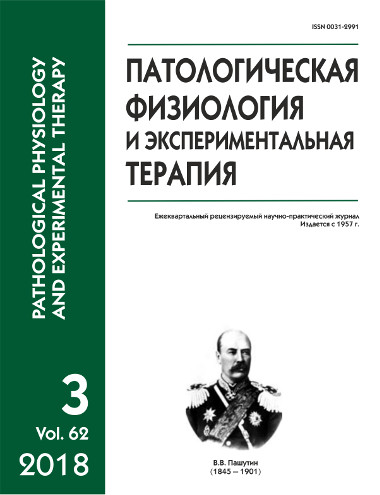Effect of opioid peptides on liver function after patial hepatectomy
Abstract
Aim. The aim of the study was to compare effects of selective agonists of opioid receptors from different classes on the protein-synthesizing function of liver and development of cytolytic and cholestatic syndromes in rats after partial hepatectomy. Methods. The study was conducted on 152 Wistar male rats weighing 200—250 g. The animals were subjected to partial hepatectomy according to the Higgins and Anderson method. Concentrations of total protein, albumin, total bilirubin, and activities of alanine aminotransferase, aspartate aminotransferase, and lactate dehydrogenase were measured in plasma using standard methods. The opioids, DAGO (6.3 mg/kg), DSLET (10.0 mg/kg), and dynorphin A (1-13) (20.1 mg/kg), were injected in 0.2 ml of saline daily for 5 days. Control animals were injected with 0.2 ml of saline for 5 days. Results. Resection of 70% of liver tissue resulted in development of liver failure as evidenced by hyperbilirubinemia, hypoalbuminemia, hypoproteinemia, and increased transaminase and lactate dehydrogenase activities. Selective agonists of opioid receptors administered to the rats after partial hepatectomy exerted a hepatoprotective effect and alleviated the signs of liver failure beginning from the 3rd day after resection. Transaminase and lactate dehydrogenase activities were significantly lower in opioid-treated rats than in the control group. Levels of total protein and albumins were significantly higher in the groups injected with the study peptides compared to the control group on the 7th day after partial hepatectomy. The selective agonist of opioid m-receptors, DAGO, exerted the most pronounced effect. Apparently, the similar effects of peptides were due to their antioxidant and anti-hypoxic action, which alleviated the detrimental effect of liver surgery. The more pronounced effect of DAGO apparently resulted from peculiarities of opioid receptors distribution or peptide resistance to endopeptidase action due to modifications of the peptide molecule. Conclusion. Administration of opioids stimulated restoration of liver functional activity after partial hepatectomy. Injections of the m-agonist, DAGO, produced the most pronounced effect.
Downloads
References
2. Vishnevskiy V.A., Kovalenko Y.A., Andreitseva O.I., Ikramov R.S., Efanov M.G., Nazarenko N.A. et al. Post-resection hepatic insufficiency: modern problems of definition, epidemiology, pathogenesis, risk factors assessment, prevention and treatment. Ukrain. zhurn. khirurgii. 2013; 3: 172-83. (in Russian)
3. Istomin N.P., Ivanov Ju.V., Panchenko D.N. Features of pancreatic and postoperative hepatic insufficiency in surgery. [Osobennosti pankreaticheskoy i posleoperatsionnoy pechenochnoy nedostatochnosti v khirurgii]. Moscow; Meditsina; 2011. (in Russian)
4. Lishmanov Ju.B., Maslov L.N. Opioid neuropeptides, stress and adaptive defense of the heart [Opioidnye neyropeptidy, stress i adaptatsionnaya zashchita serdtsa]. Tomsk: Izdatelstvo Tomskogo universiteta; 1994. (in Russian)
5. Yang D.J., Lee K.S., Ko C.M., Moh S.H., Song J., Hur L.C. et al. Leucine-enkephalin promotes wound repair through the regulation of hemidesmosome dynamics and matrix metalloprotease. Peptides. 2016; 76(1): 57-64.
6. Solin A.V., Lyashev Ju.D. The effect of opioid peptides on stress-induced changes in liver tissue in animals of different typological groups. Nauch. vedom. BGU. Meditsina. Farmatsiya. 2016; 36: 120-6. (in Russian)
7. Higgins G.M., Anderson R.M. Experimental Pathology of the Liver. 1. Restoration of the Liver of the White Rat Following Partial Surgical Removing. Arch. of Pathol. 1931; 12(2): 186-202.
8. Laboratory methods of research in the clinic. [Laboratornye metody issledovaniya v klinike]. Pod red. V.V. Men’shikova. Moscow; «Meditsina»; 1987. (in Russian)
9. Smorodskiy A.V., Ioncev V.I. Perspectives of surgical treatment of complications of portal hypertension in cirrhosis in patients with decompensated hepatic impairment. Vestnik Rossiyskoy voenno-meditsinskoy akademii. 2010; 1: 210-6. (in Russian)
10. Mullen J.T., Ribero D., Reddy S.K., Donaldson M., Zorzi D., Gautam S. et al. Hepatic insufficiency and mortality in 1059 noncirrhotic patients undergoing major hepatectomy. J. Am. coll. surg. 2007; 204(5): 854-62.
11. Dzidzava I.I., Slobodjanik A.V., Ioncev V.I. Complications after extensive liver resections. Vestnik rossiyskoy voenno-meditsinskoy akademii. 2015; 51(3): 261-6. (in Russian)
12. Lishmanov Yu.B., Maslov L.N., Naryzhnaya N.V., Pei Zh.-M., Kolar F., Zhang I. et al. Endogenous opioid system as the link of urgent and prolonged adaptation of the organism to extremal actions. The perspectives of clinical usage of opioid peptides. Vest. RAMN. 2012; 67(6): 73-82. (in Russian)
13. Lishmanov Yu.B., Naryzhnaya N.V., Maslov L.N., Gross H.J. Opiatergic link of the antiarrhythmic effect of adaptation to hypoxia on the model of ischemia and reperfusion in vivo. Patologicheskaya Fiziologiya i Eksperimental`naya Terapiya. 2003; 1: 19-21. (in Russian)
14. Panchenko L.F., Mitjushina N.V., Firstova N.V., Gengin M.T. Metabolism of enkephalins in various functional and pathological conditions of the body. Voprosy meditsinskoy khimii. 1999; 45(4): 277-88. (in Russian)






